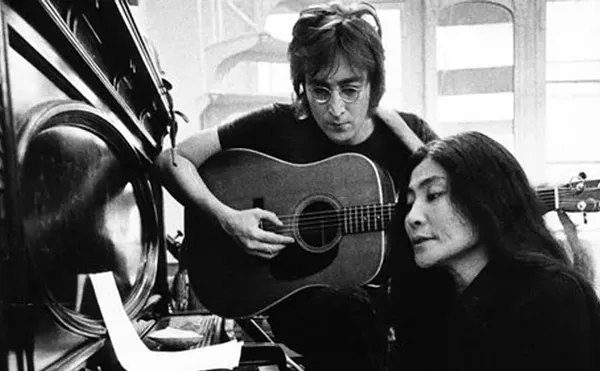
Audio By Carbonatix
[
{
"name": "GPT - Leaderboard - Inline - Content",
"component": "35519556",
"insertPoint": "5th",
"startingPoint": "3",
"requiredCountToDisplay": "3",
"maxInsertions": 100,
"adList": [
{
"adPreset": "LeaderboardInline"
}
]
}
]
Sometimes a return to fundamentals is a way of going forward. “Primary,” Maria Prainito’s show of new paintings at Detroit’s Tangent Gallery, makes a point of doing just that in more ways than one.
The most obvious of Prainito’s strategies is her restricted palette — red, yellow, blue, white and black — in works that mine the real and the imaginary (the autobiographical, natural and aesthetic worlds) for their subjects. And yet there are other “basic” approaches here, one of which involves her commitment to two centuries-old genres — portraits and landscapes.
Prainito’s portraits are of babies: A sequence of three mini-icons freezes our gaze on the head of a little girl, but most of the painter’s portrait suites capture the face and body of her infant son. Primary Study: Baby, a trio of canvases, greets gallery visitors with 6-foot-high renderings of a naked boy, standing and gesturing at something unseen by us. In the left, red-dominated panel, the little big man is surprised at an offscreen event. In the right panel, saturated in blue, junior stares into space with a mixture of fascination and delight. And in the yellow center panel, the future citizen confronts us with determination. Aside from such facial signals, these works are all about sturdy little-boy torsos, arms, legs, hands, feet and penises as visual facts.
But the portraits that make the biggest impact are a row of nine 6 inch-by-6 inch images called 81 Seconds: Baby Study. These paintings (three in red, three in yellow and three in blue) are based on photographs taken 81 seconds apart, capturing the boy’s shifting expressions and making us recognize him as a different person from one slice of time to the next. There are black bars behind his head in the red sequence (pictured), maybe from a crib, and his amazement at being looked at gives each image a kind of mug shot drama. In one, he’s a little tyke — in another, he looks like Dutch Schultz or Al Capone.
Prainito’s most radical disruption of our sensibilities occurs in her primary-hued landscapes (with a red-, yellow- and blue-dominated canvas in each set). Always presenting them in groups of three, she concentrates on dramatically mournful vistas that have been bulldozed to make way for one development scheme or another. In Land: Study III, for instance, the blue panel is frantic with flailing trees; in the yellow panel, rows of earth swoop toward us like scars; the red panel is serenely psychotic. The paint in each of these tableaus is gobbed, smeared and puddled on, with a painter’s chutzpah replacing any concern for naturalistic truth. And everywhere black shadows remind us that time, like the sun, is both frozen and moving on. …
The third and most audacious group of paintings in “Primary” is a series of double canvases (one hung above the other) that comments on and digests the work of a number of unidentified artists, most from the Detroit scene and a few of national renown. In each pair, Prainito replicates the style and gestures of the originals, but also adds her own telltale yellow blotches to partially obliterate and rewrite the works in question. This strategy is part of a “homage” tradition that goes back hundreds of years. And in this case, there’s a humor and elegance about the “forgeries” that makes us think beyond the worn-out notion of the copy.
Ars longa, vita brevis.
Tangent Gallery is one of a growing number of art, music and performance projects in the warehouse district east of Woodward and south of Grand Boulevard. It’s one of the largest naturally lit art spaces in town.
“Primary,” new paintings by Maria Prainito, is at Tangent Gallery (715 E. Milwaukee, Detroit) through May 25. Call 313-875-7303.
George Tysh is arts editor of Metro Times. E-mail gtysh@metrotimes.com




